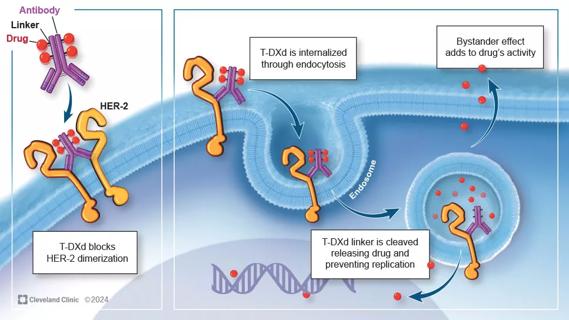Chief medical officer describes process

By Mark Stovsky, MD, MBA
Advertisement
Cleveland Clinic is a non-profit academic medical center. Advertising on our site helps support our mission. We do not endorse non-Cleveland Clinic products or services. Policy
In November 2013, Cleveland Clinic announced a new spinoff company, Cleveland Diagnostics (CDx), with the objective of providing an institutional platform for increasing the accuracy of diagnostic tests for many types of cancer.
As Chief Medical Officer of CDx, Science and Technology Innovations Officer of Cleveland Clinic’s commercialization arm, Cleveland Clinic Innovations, and a staff physician within the Glickman Urological & Kidney Institute, I have enjoyed a front-row seat for CDx’s journey from concept to market and have learned several lessons along the way. Above all: Trust in Cleveland Clinic Innovations (CCI) to lead the way.
The idea for CDx originated in 2013 and stemmed from the work of researchers at Cleveland-based AnalizaDx LLC, as well as physicians at Cleveland Clinic, Case Western Reserve University School of Medicine and the VA Boston Healthcare System.
To diagnose or assess the risk of cancer, scientists for years have focused narrowly on changes in the concentration of a single protein in biological fluids such as blood or urine or, alternatively, on genetic mutations. However, the diagnostic accuracy of single or multiple protein quantification tests has suffered from relatively poor sensitivity, specificity and predictive values, which limit clinical utility, while tests that identify multiple genetic mutations associated with cancer are difficult to transform into actionable results. These shortcomings result in poor clinical performance, an ineffective allocation of diagnostic resources, and substantial patient anxiety and dissatisfaction.
Advertisement
Our idea was to build a breakthrough biomarker platform that focuses on changes in the structure of certain proteins circulating in blood or other biological fluids to indicate the presence or absence of cancer. Proprietary tests, based on the novel Solvent Interaction Analysis (SIA) technology, would evaluate the structure of protein biomarkers and differentiate those produced by cancer in comparison with benign cells.
We achieved the potential for commercial success with the completion of an initial validation trial of the SIA technology in the diagnosis of prostate cancer. In this multicenter trial, the technology demonstrated favorable preliminary results. When compared with standard serum total prostate specific antigen (PSA) testing, the proprietary PSA/SIA (today called IsoPSA) test showed 100 percent sensitivity with no false negatives and approximately 80 percent specificity. Those results compare favorably with those of the traditional serum PSA test.
Further analysis of data from serum appeared to show similar diagnostic accuracy for prostate cancer. Other preliminary results in breast and ovarian cancer detection demonstrated that SIA potentially could be used as a platform technology to diagnose a broad spectrum of cancers.
We knew we had a product that could have an immediate impact. But the research findings, as well as the intellectual property implications of a multicenter discovery, required significant commercialization guidance from experts. In fall 2013, Cleveland Clinic Innovations professionals assessed the concept, and the framework for a spinoff company was born. The newly formed CDx would mesh the intellectual property and technology expertise of AnalizaDx LLC, the clinical bandwidth of Cleveland Clinic, and the commercialization capability and know-how of CCI to commercialize the novel cancer testing platform.
Advertisement
With the strategy in place, CDx underwent a rigorous review to assess important factors including the company’s commercial potential, the funding necessary to support a successful venture, the competitive and regulatory environments, and the time frame for bringing products to market. After formal approval by Cleveland Clinic and CCI leadership as well as CCI’s advisory board (which consists of outside advisors), CDx received initial seed funding and became the 65th CCI portfolio company.
While CDx’s journey to commercialization has at times been challenging — as is the case for most new medical companies and products — CCI has helped minimize problems through the use of its new INVENTSM process.
INVENT stands for Idea submission, Need assessment, Viability assessment, Enhancement, Negotiation and Translation. The INVENT process guides an inventor from conception to commercialization.
At Cleveland Clinic, each institute, including the Glickman Urological & Kidney Institute, is assigned an innovation manager. The manager acts as the CCI point of contact as an invention is assessed by institute peers and CCI professionals, is further developed in one of four incubators (Medical Devices, Therapeutics & Diagnostics, Health Information Technology and Delivery Solutions), and is licensed to an industry partner or transitioned into a Cleveland Clinic spinoff company.
CDx continues to benefit greatly from CCI’s ability to identify an opportunity with broad institutional platform appeal, assess the myriad factors involved in the technology development and commercialization process, and develop a plan to bring a potentially groundbreaking technology from bench to market.
Advertisement
As with CDx, it all starts with an idea.
Dr. Stovsky is a staff member of the Department of Urology in Cleveland Clinic’s Glickman Urological & Kidney Institute and Science and Technology Innovations Officer of Cleveland Clinic Innovations.
Advertisement
Advertisement

First-of-its-kind research investigates the viability of standard screening to reduce the burden of late-stage cancer diagnoses

Global R&D efforts expanding first-line and relapse therapy options for patients

Study demonstrates ability to reduce patients’ reliance on phlebotomies to stabilize hematocrit levels

A case study on the value of access to novel therapies through clinical trials

Findings highlight an association between obesity and an increased incidence of moderate-severe disease

Cleveland Clinic Cancer Institute takes multi-faceted approach to increasing clinical trial access 23456

Key learnings from DESTINY trials

Overall survival in patients treated since 2008 is nearly 20% higher than in earlier patients